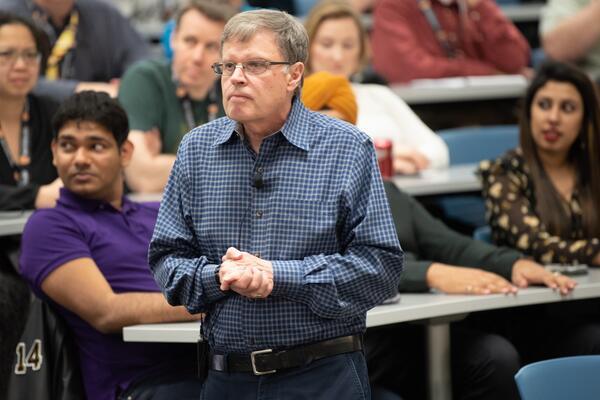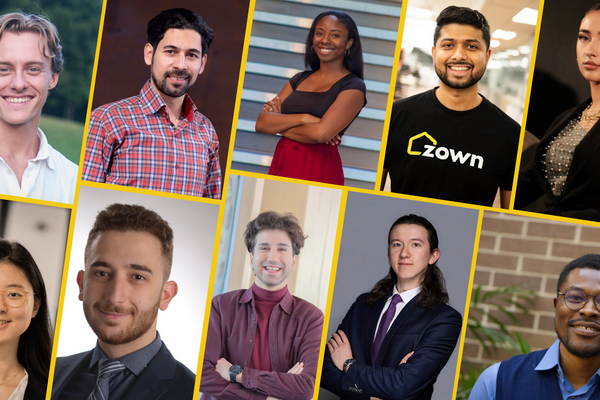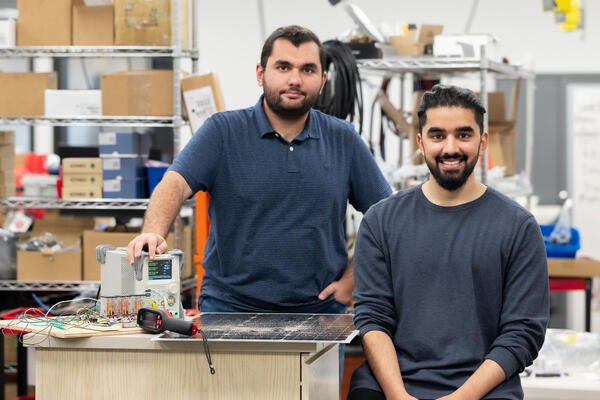
New armband uses muscle power to control electronics remotely
Thalmic Labs is on the frontier of wearable computer controllers.

Thalmic Labs is on the frontier of wearable computer controllers.
By Tenille Bonoguore Communications and Public AffairsThe idea hit a few weeks before graduation in April 2012: University of Waterloo students Matthew Bailey and Stephen Lake were sitting at a bar talking about the new frontier of wearable computer controllers.
Lake mentioned work he'd done studying muscle activity in his biomechanics courses. Perhaps, the pair mused, the electronics could be shrunk to a wearable size.
Thus, Thalmic Labs was born.
"We prototyped the idea, proved that it was viable one week after graduation, and have been working on it ever since," Bailey says.
25,000 armbands sold
 Thalmic Labs co-founders Stephen Lake, Matthew Bailey and Aaron Grant (l-r).
Thalmic Labs co-founders Stephen Lake, Matthew Bailey and Aaron Grant (l-r).
The concept won a $25,000 grant through the VeloCity Venture Fund, and was further developed at VeloCity Garage. The team also developed a solid business plan that earned it a $60,000 Scientists and Engineers in Business Fellowship which kick-started interest from other investors.
Just one year after developing their prototype, co-founders Bailey, Lake and Aaron Grant employ 15 people, have sold 25,000 MYO armbands with more orders rolling in. They are building on their promise to change the look and feel of technological interaction.
In a tough market populated with tech heavyweights, Thalmic Labs has been generating a near-constant stream of buzz and interest within the tech community and beyond.
"Thousands of people have emailed us with different ways in which they'll use MYO and how they think it will change their lives," Bailey says.
That excitement has not only spurred pre-sales - it has enabled the company to attract top-tier talent to their startup. Next up, the team wants to encourage developers and hackers to push the limits of what MYO can do.
Prestigious Y Combinator
It's been a hectic year for the founders, who spent three months as part of San Francisco's prestigious Y Combinator startup accelerator.
But it's not the sales or the interest that the co-founders consider their greatest success. Rather, they speak highest about community response, and where that enthusiasm could lead.
"The greatest success and motivator for us is the large, passionate community that we've built around an idea that we had less than one year ago," Bailey says.
With developers and hackers integrating the device with their products and projects, we know that we'll make an even larger impact on how the world interacts with technology."

Read more
For more than four decades, Waterloo professor Larry Smith has helped build the University's reputation for innovation and entrepreneurial excellence

Read more
From transforming solutions for homeownership to advancing health care interventions, Waterloo talent continues to disrupt industries and drive change

Amirhossein Boreiri (left), Swish Solar's Chief Technology Officer, and Miswar Syed, Chief Executive Officer, are the latest Velocity-based company to raise pre-seed funding. (Velocity / University of Waterloo)
Read more
Velocity cleantech company closes pre-seed round, financing will help accelerate market adoption of its self-cleaning solar technology
The University of Waterloo acknowledges that much of our work takes place on the traditional territory of the Neutral, Anishinaabeg, and Haudenosaunee peoples. Our main campus is situated on the Haldimand Tract, the land granted to the Six Nations that includes six miles on each side of the Grand River. Our active work toward reconciliation takes place across our campuses through research, learning, teaching, and community building, and is co-ordinated within the Office of Indigenous Relations.